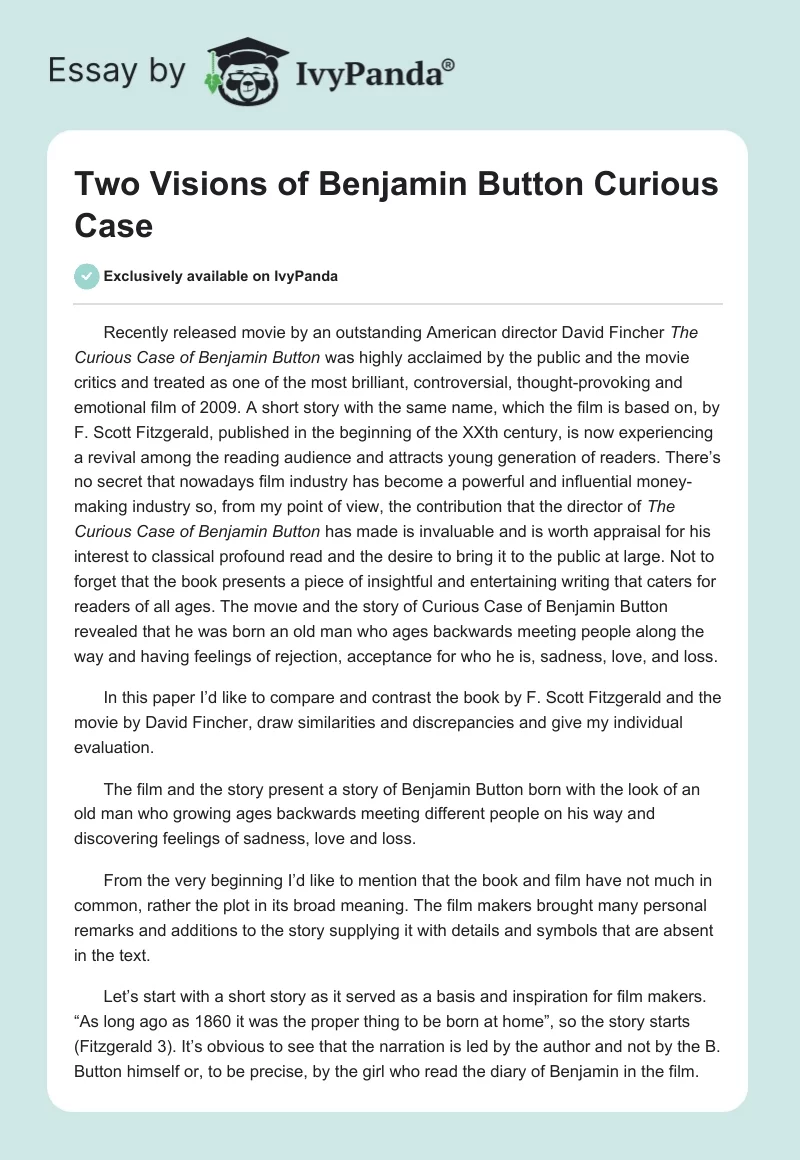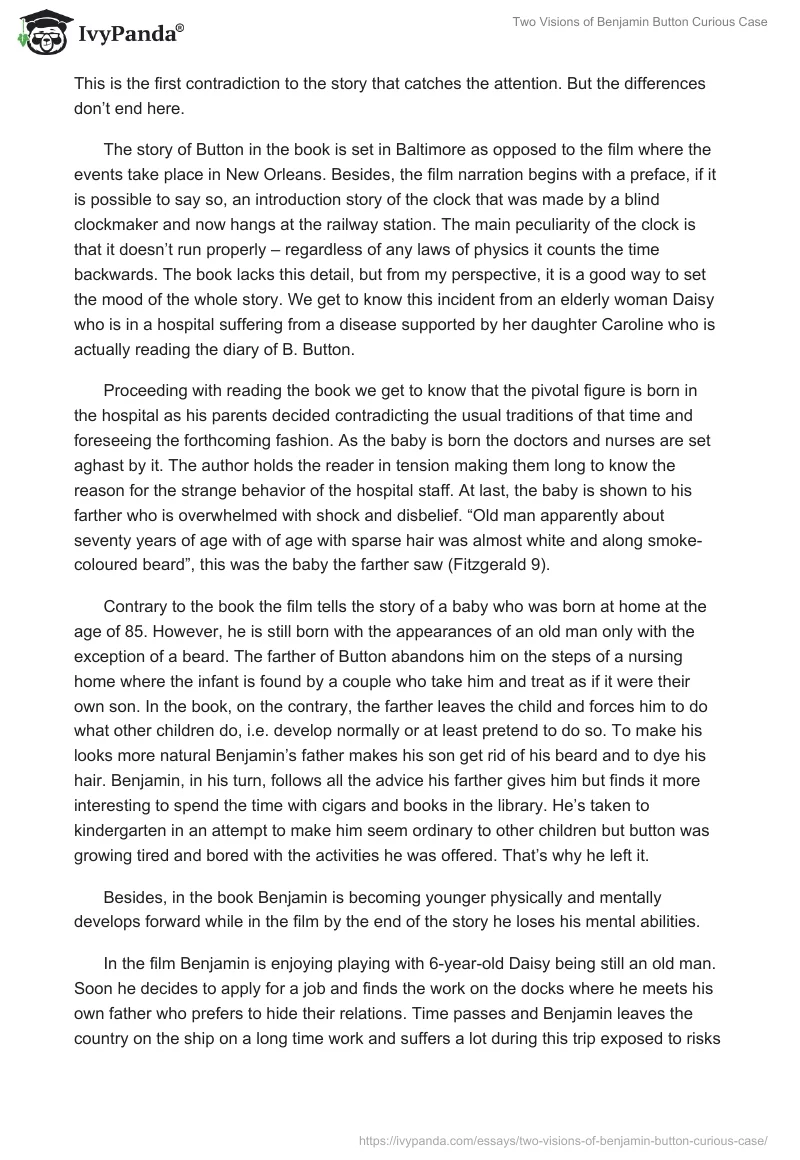Recently released movie by an outstanding American director David Fincher The Curious Case of Benjamin Button was highly acclaimed by the public and the movie critics and treated as one of the most brilliant, controversial, thought-provoking and emotional film of 2009. A short story with the same name, which the film is based on, by F. Scott Fitzgerald, published in the beginning of the XXth century, is now experiencing a revival among the reading audience and attracts young generation of readers. There’s no secret that nowadays film industry has become a powerful and influential money-making industry so, from my point of view, the contribution that the director of The Curious Case of Benjamin Button has made is invaluable and is worth appraisal for his interest to classical profound read and the desire to bring it to the public at large. Not to forget that the book presents a piece of insightful and entertaining writing that caters for readers of all ages. The movιe and the story of Curious Case of Benjamin Button revealed that he was born an old man who ages backwards meeting people along the way and having feelings of rejection, acceptance for who he is, sadness, love, and loss.
In this paper I’d like to compare and contrast the book by F. Scott Fitzgerald and the movie by David Fincher, draw similarities and discrepancies and give my individual evaluation.
The film and the story present a story of Benjamin Button born with the look of an old man who growing ages backwards meeting different people on his way and discovering feelings of sadness, love and loss.
From the very beginning I’d like to mention that the book and film have not much in common, rather the plot in its broad meaning. The film makers brought many personal remarks and additions to the story supplying it with details and symbols that are absent in the text.
Let’s start with a short story as it served as a basis and inspiration for film makers. “As long ago as 1860 it was the proper thing to be born at home”, so the story starts (Fitzgerald 3). It’s obvious to see that the narration is led by the author and not by the B. Button himself or, to be precise, by the girl who read the diary of Benjamin in the film. This is the first contradiction to the story that catches the attention. But the differences don’t end here.
The story of Button in the book is set in Baltimore as opposed to the film where the events take place in New Orleans. Besides, the film narration begins with a preface, if it is possible to say so, an introduction story of the clock that was made by a blind clockmaker and now hangs at the railway station. The main peculiarity of the clock is that it doesn’t run properly – regardless of any laws of physics it counts the time backwards. The book lacks this detail, but from my perspective, it is a good way to set the mood of the whole story. We get to know this incident from an elderly woman Daisy who is in a hospital suffering from a disease supported by her daughter Caroline who is actually reading the diary of B. Button.
Proceeding with reading the book we get to know that the pivotal figure is born in the hospital as his parents decided contradicting the usual traditions of that time and foreseeing the forthcoming fashion. As the baby is born the doctors and nurses are set aghast by it. The author holds the reader in tension making them long to know the reason for the strange behavior of the hospital staff. At last, the baby is shown to his farther who is overwhelmed with shock and disbelief. “Old man apparently about seventy years of age with of age with sparse hair was almost white and along smoke-coloured beard”, this was the baby the farther saw (Fitzgerald 9).
Contrary to the book the film tells the story of a baby who was born at home at the age of 85. However, he is still born with the appearances of an old man only with the exception of a beard. The farther of Button abandons him on the steps of a nursing home where the infant is found by a couple who take him and treat as if it were their own son. In the book, on the contrary, the farther leaves the child and forces him to do what other children do, i.e. develop normally or at least pretend to do so. To make his looks more natural Benjamin’s father makes his son get rid of his beard and to dye his hair. Benjamin, in his turn, follows all the advice his farther gives him but finds it more interesting to spend the time with cigars and books in the library. He’s taken to kindergarten in an attempt to make him seem ordinary to other children but button was growing tired and bored with the activities he was offered. That’s why he left it.
Besides, in the book Benjamin is becoming younger physically and mentally develops forward while in the film by the end of the story he loses his mental abilities.
In the film Benjamin is enjoying playing with 6-year-old Daisy being still an old man. Soon he decides to apply for a job and finds the work on the docks where he meets his own father who prefers to hide their relations. Time passes and Benjamin leaves the country on the ship on a long time work and suffers a lot during this trip exposed to risks and danger because of the World War. When he gets back home safe and sound he gets to know about his real farther and inherit his house and factory.
The story in the book unfolds in a different way. Button being 18 years old goes to Yale University but was expelled for his appearance of a 50-year-old man. On one occasion Benjamin meets young Hildegarde Moncrief and falls in love with her. Preferring older man the girl gives her consent to their marriage and they become to live together. Benjamin runs his father’s business and proves to be very successful in it. Growing and naturally becoming older his wife doesn’t attract him anymore as Benjamin undergoes the reverse – becoming younger “the blood flowed with new vigour through his veins” – Fitzgerald describes (Fitzgerald 34). So he takes the decision to take part in the Spanish-American War contrary to the film where Benjamin witnesses the World War. Button served the country wholeheartedly and received a medal for it. When he gets back home “he looked now like a man of thirty” while his wife was losing her appeal (Fitzgerald 41).
Benjamin in the film having returned from long time absence meets his childhood friend Daisy who is a dancer and married at that time, which make them part. But after Daisy had ended her career after an accident where she had her leg broken the faith brings them together again and they marry and have a child. Benjamin, looking young and fresh and believing he’s unable to be a good father leaves his possessions to his family and goes travelling.
Contrary, in the book Benjamin never leaves his family, it is his wife who leaves him as Button has become a young looking boy enjoying boyish activities, such as partying and dancing. He also goes to the university, this time Harvard and shows great results in his studying. In addition, he becomes a successful football player full of energy and vigour. Unfortunately, Benjamin is able to stay there only for two years and lives the university due to his growing weakness. Eventually, he becomes a young boy and then a child preferring toys and games. His son is now older than Benjamin himself. Thus, Benjamin meets the end of his life looking like a baby.
Similar to the book Benjamin in the film is taken care of by the woman he loved, Daisy who left her husband for him. A teenager now, Benjamin loses his ability to remember things, faces and events and becomes younger and younger with every day. At the end of the film the clock at the station is shot as a symbol of reverse life.
To conclude I’d like to say that despite all the discrepancies both the movie and the film are worth seeing.
References
Fitzgerald, Scott. The Curious Case of Benjamin Button. Claremont, CA: Coyote Canyon Press, 2008.


